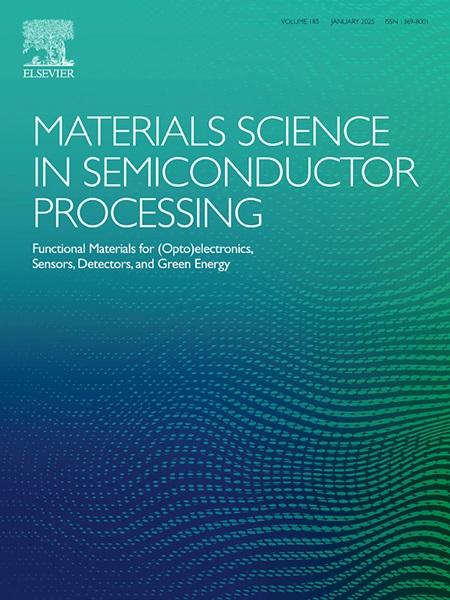Study on the constant potential electrodeposition of Se-Sb binary semiconductor alloy in DES and its application in photoelectricity
IF 4.2
3区 工程技术
Q2 ENGINEERING, ELECTRICAL & ELECTRONIC
引用次数: 0
Abstract
In this study, Se-Sb alloy coatings were successfully fabricated for the first time via constant potential electrodeposition from a choline chloride–ethylene glycol deep eutectic solvent. The correlation between deposition potential and the morphology, composition, crystal phase, optical, and electrical properties of the coatings was systematically investigated. The results showed that as the deposition potential shifted in the negative direction, the fibrous morphology of the coatings initially became denser and subsequently looser. Correspondingly, the Se content first decreased and then increased, while the Sb content exhibited the opposite trend. The crystalline structure was primarily characterized by an amorphous Sb2Se3 phase. Although both the bandgap and photocurrent response initially increased and then decreased with more negative deposition potentials, the coatings consistently exhibited excellent p-type semiconductor characteristics.
Chronoamperometry (CA) analysis indicated that the nucleation mechanism of Se-Sb alloys transitioned from diffusion-controlled three-dimensional (3D) progressive nucleation to diffusion-controlled 3D instantaneous nucleation as the deposition potential shifted from −0.45 V to −0.65 V. Furthermore, cyclic voltammetry (CV) analysis revealed an induced co-deposition mechanism: Se was first deposited on the FTO substrate, which subsequently induced the co-deposition of Se and Sb to form the Se-Sb alloy coatings. Finally, a comparison with coatings annealed at 300 °C demonstrated that annealing significantly improved the crystallinity, resulting in the formation of crystalline Sb2Se3. However, the photocurrent response decreased by a factor of 5.18. These findings suggest that the as-deposited Se-Sb alloy coatings exhibit superior photoelectrical performance compared to their annealed counterparts, highlighting their promising potential for photoelectric applications.
Se-Sb二元半导体合金在DES中恒电位电沉积及其在光电中的应用研究
本研究首次以氯化胆碱-乙二醇深共晶溶剂为原料,采用恒电位电沉积法制备了Se-Sb合金镀层。系统地研究了沉积电位与镀层的形貌、组成、晶相、光学和电学性能之间的关系。结果表明,随着沉积电位向负方向移动,涂层的纤维形态开始变得致密,随后变得松散。相应的,Se含量先降低后升高,Sb含量则相反。晶体结构主要为非晶Sb2Se3相。虽然随着负沉积电位的增加,带隙和光电流响应先增大后减小,但涂层始终表现出优异的p型半导体特性。计时安培法(CA)分析表明,随着沉积电位从−0.45 V转变为−0.65 V, Se-Sb合金的成核机制由扩散控制的三维渐进成核转变为扩散控制的三维瞬时成核。此外,循环伏安法(CV)分析揭示了诱导共沉积机制:Se首先沉积在FTO衬底上,随后诱导Se和Sb共沉积形成Se-Sb合金涂层。最后,与300℃退火涂层的对比表明,退火显著提高了涂层的结晶度,形成了Sb2Se3晶体。然而,光电流响应降低了5.18倍。这些发现表明,与退火后的Se-Sb合金涂层相比,沉积态Se-Sb合金涂层具有优越的光电性能,突出了其在光电应用方面的潜力。
本文章由计算机程序翻译,如有差异,请以英文原文为准。
求助全文
约1分钟内获得全文
求助全文
来源期刊

Materials Science in Semiconductor Processing
工程技术-材料科学:综合
CiteScore
8.00
自引率
4.90%
发文量
780
审稿时长
42 days
期刊介绍:
Materials Science in Semiconductor Processing provides a unique forum for the discussion of novel processing, applications and theoretical studies of functional materials and devices for (opto)electronics, sensors, detectors, biotechnology and green energy.
Each issue will aim to provide a snapshot of current insights, new achievements, breakthroughs and future trends in such diverse fields as microelectronics, energy conversion and storage, communications, biotechnology, (photo)catalysis, nano- and thin-film technology, hybrid and composite materials, chemical processing, vapor-phase deposition, device fabrication, and modelling, which are the backbone of advanced semiconductor processing and applications.
Coverage will include: advanced lithography for submicron devices; etching and related topics; ion implantation; damage evolution and related issues; plasma and thermal CVD; rapid thermal processing; advanced metallization and interconnect schemes; thin dielectric layers, oxidation; sol-gel processing; chemical bath and (electro)chemical deposition; compound semiconductor processing; new non-oxide materials and their applications; (macro)molecular and hybrid materials; molecular dynamics, ab-initio methods, Monte Carlo, etc.; new materials and processes for discrete and integrated circuits; magnetic materials and spintronics; heterostructures and quantum devices; engineering of the electrical and optical properties of semiconductors; crystal growth mechanisms; reliability, defect density, intrinsic impurities and defects.
 求助内容:
求助内容: 应助结果提醒方式:
应助结果提醒方式:


